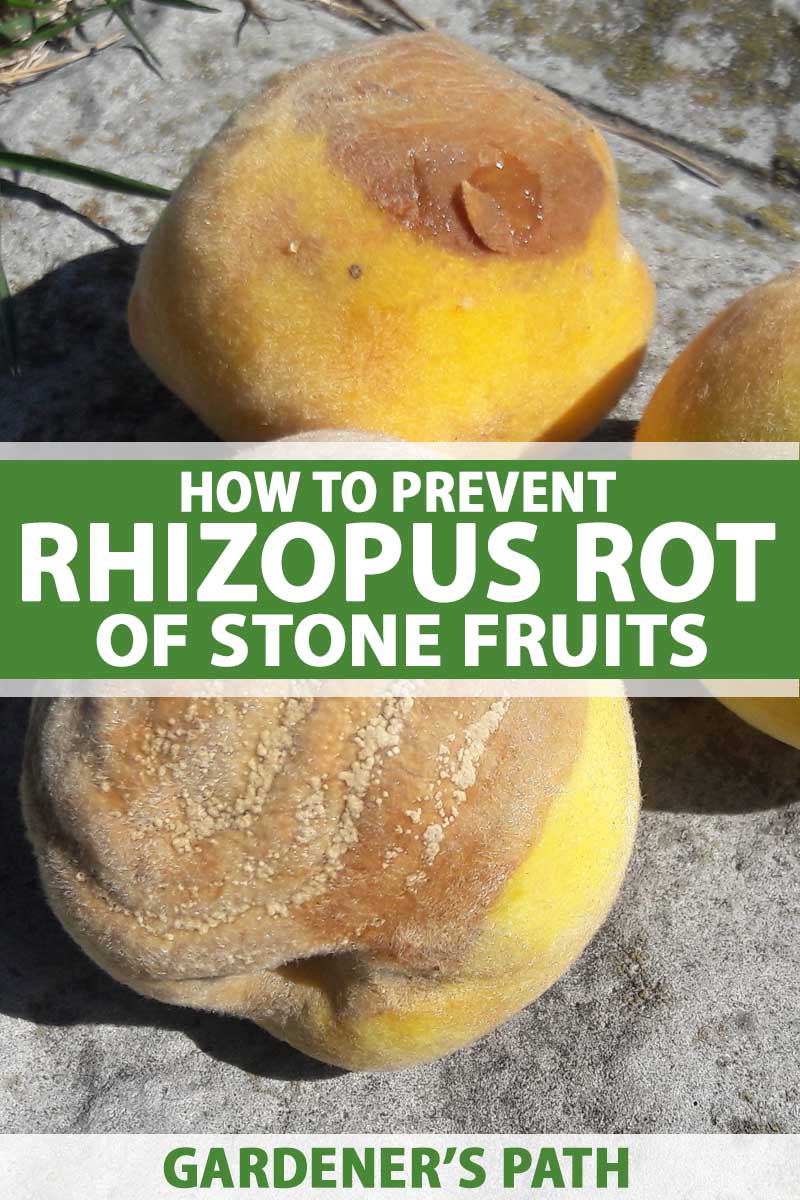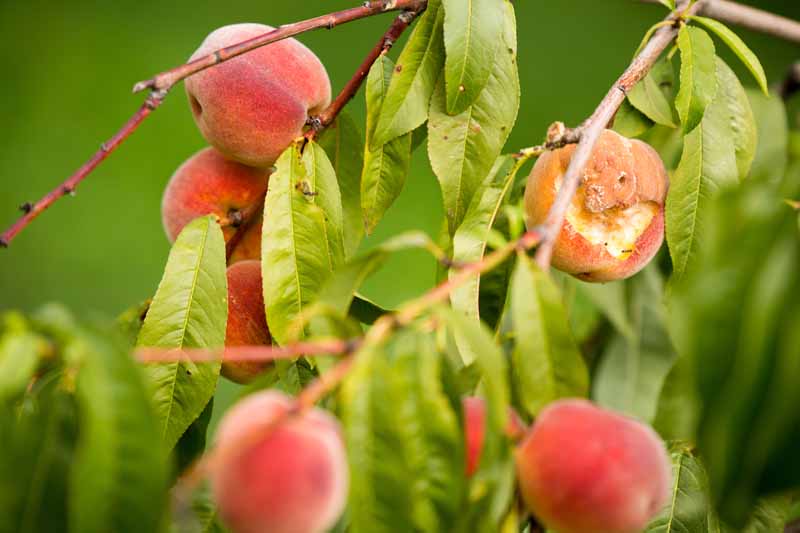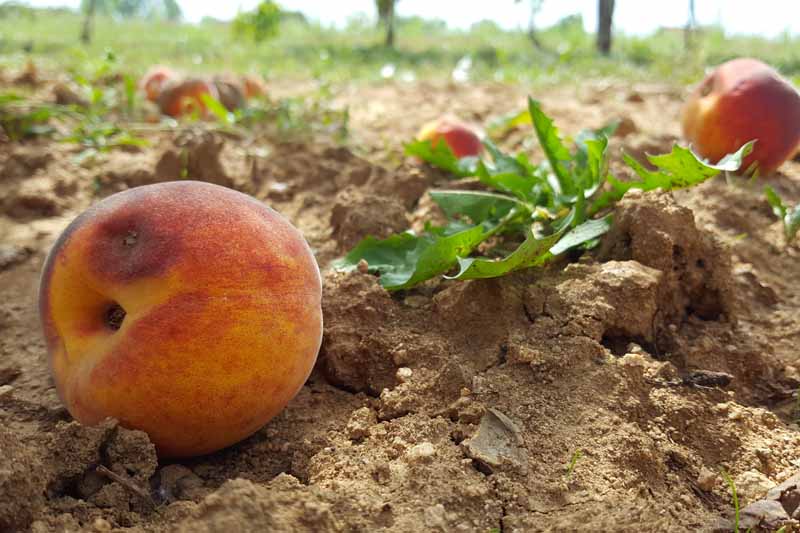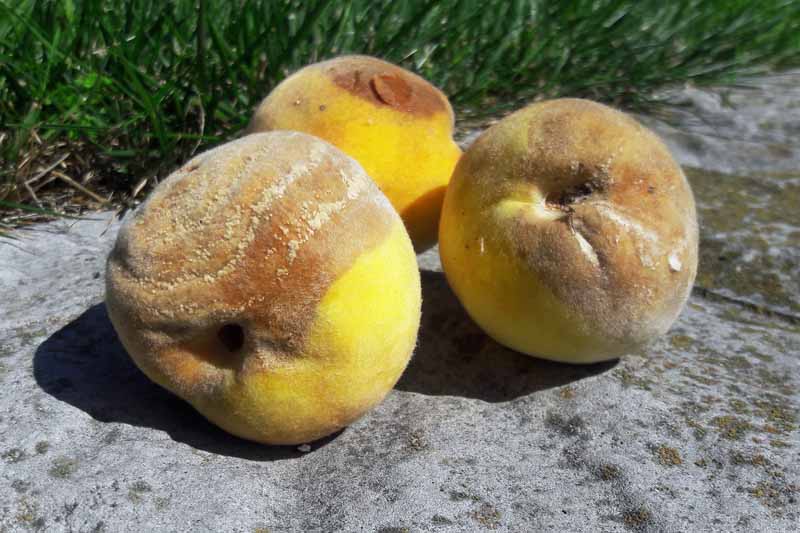Rhizopus stolonifer
Rhizopus is an insidious fungus that can rot ripe apricots, peaches, nectarines, and plums. The most common infections are caused by Rhizopus stolonifer, although there are other species that can also be involved.
The soft rot caused by this fungus is either the most serious postharvest infection of stone fruits or the second most serious depending on where you live.
While this fungus can infect ripe fruit on a tree, it can really go to town on postharvest produce. It can destroy a whole crate of fruit if the temperatures are right.

We link to vendors to help you find relevant products. If you buy from one of our links, we may earn a commission.
And even canned apricots or peaches are not safe! While heating may kill the fungi, their pectic enzymes persist and can destroy a can over time.
However, there are steps you can take to prevent Rhizopus from rotting your crop. We at Gardener’s Path will describe the steps you can take to save your harvest.
What You Will Learn
Symptoms of Rhizopus Rot
The infection starts out as a circular tan area around an island of fruit that looks healthy.
However, appearances can be deceiving. All of the skin in the area will become tan to brown within a few hours.
A classic symptom that indicates that Rhizopus is the cause is that the skin will slip off from the flesh if you put slight pressure on it.
Next, fluffy white growth of the fungus becomes visible near the center and rapidly colonizes the whole area.
Within 24 hours of the time the infection starts, the fungus turns black as it produces enormous quantities of spores.
This has been described as looking like your fruit have whiskers.
At warmer temperatures, the rot will spread over the entire surface and into the flesh.
When Stone Fruits are the Most Susceptible
Rhizopus will not usually start to infect fruit unless they have been bruised or injured.

This infection can occur on immature specimens, but it proceeds slowly. However, fruit that are near ripe or ripe can be highly vulnerable.
The fungus is most active during warm humid weather. Even temperatures as low as 68-77 F enable the fungus to spread.
And once it does get started, it can rot entire clusters of fruit on the tree.
Prevention
Fortunately, there are steps you can take to minimize infection.
1. Orchard Sanitation
Ridding the area of fruit fall is a great first step.

Pick up remains from the ground and remove any fruit mummies from your tree.
2. Consider Preharvest Fungicides
If you are growing fruit just for yourself, you probably don’t need to resort to fungicides.However, if you will be selling your crop, and your orchard has a history of Rhizopus soft rot, you may want to treat your trees with an appropriate fungicide before harvest.
3. Handle Your Harvest Carefully
Try to handle the harvest as little as possible.
Be gentle with your fruit, so you don’t bruise them or introduce any injuries.
This makes such a difference that Texas A&M University advises commercial growers to “pad any area where fruit will drop onto a belt or roller.”
4. Keep Things Cool
Rapidly storing the harvest in a cool place can strongly minimize the appearance of symptoms.
The fungus cannot grow or germinate spores at temperatures below 45 F. Therefore, experts recommend storage at 41 F.
However, if infection is present, the disease can progress rapidly once you take your stone fruit out of refrigeration and subject them to warmer temperatures.
Canning Your Harvest Can Be a Challenge
If you will be canning your harvest, you should try and avoid any fruit that have been near ones with soft rot.
Even produce that looks fine on the surface can have enough of an infection that their pectic enzymes will dissolve the pectin in the cell walls over time.
This results in apricot or peach pieces that dissolve when removed from the can.
The fungi produce these enzymes very early in the infection process.
While the heat treatment will kill the fungus, some of these enzymes will persist and can destroy a whole can within eight months.
Research at the University of California in Davis found that some of the enzymes retained activity even after being heated at 212 F for 20 minutes!
Other research found that the equivalent of a single drop of juice from a rotted fruit is enough to destroy a whole can.
And to put it succinctly: “The resulting product is highly objectionable to the consumer.”
Aggressively spraying your harvest with water and then dipping them in a solution of lye can protect against this canning disorder.
Avoidance is Your Best Bet
Fortunately, Rhizopus typically only rots apricots, peaches, nectarines, and plums that are highly ripe.
However, it can be a very serious infection that could cost you a substantial amount of your crop.

Fortunately, you can minimize the chances of infection by practicing good sanitation around your tree, handling the harvest carefully, and refrigerating the produce as soon as possible.
However, if you do end up with this pernicious rot, quickly destroy the infected individuals, or the spores could rapidly.Have you had the misfortune to get Rhizopus on your stone fruits? If so, let us know if you were able to stop the infection in the comments. And if you haven’t nailed down the type of rot or disease that might be affecting your trees or harvest, then these guides may be of help:
- How to Identify, Prevent, and Treat Scab in Stone Fruits
- How to Diagnose and Prevent Phony Peach Disease
© Ask the Experts, LLC. ALL RIGHTS RESERVED. See our TOS for more details. Uncredited photos: Shutterstock.

I get Rhizopus on my peaches every year, and now I know what it is. But, you didn’t say what to use to stop it. Which fungicide should we use?
Hi Kristy,
Thank you so much for your question! You are correct. Choosing the right fungicide to treat this disease can be complicated, and most of the effort against it is usually devoted to prevention: be extremely careful to prevent punctures and skin cuts during harvest and packing. However, Dr. Kari Peter of Penn State Extension advises two fungicides that are labeled to control Rhizopus in peaches. One is Merivon, while the other is Luna Sensation. I hope that one of these will work for you! Please let us know how your harvest turns out.